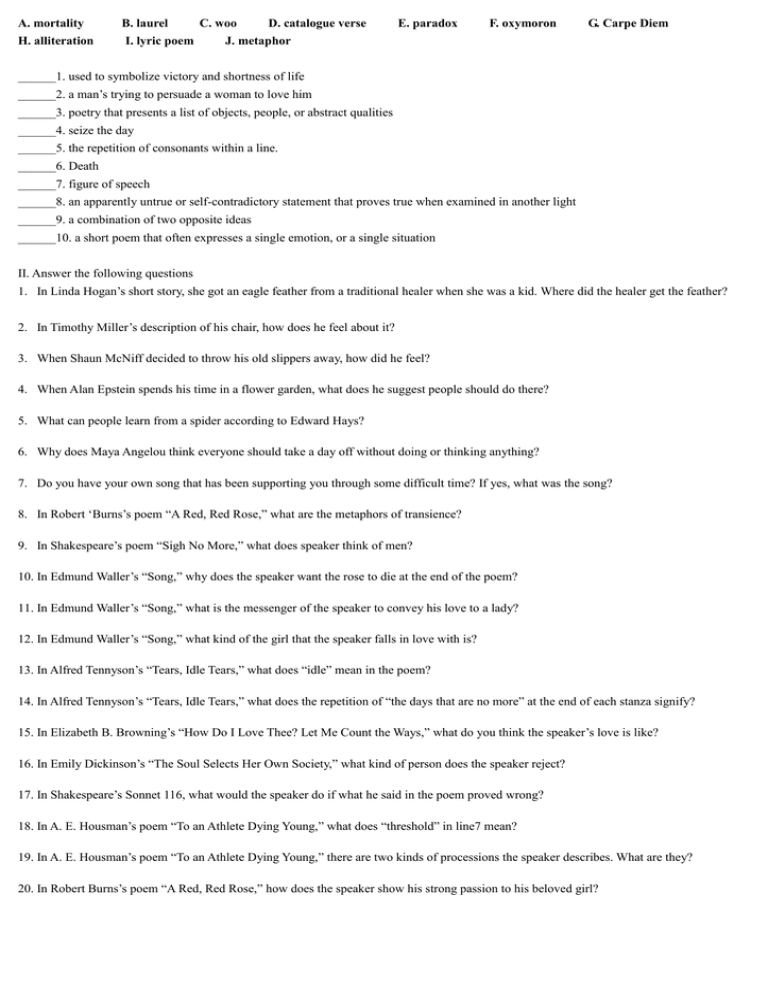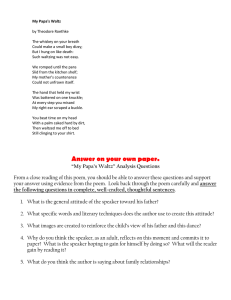Document 15874360
advertisement

A. mortality B. laurel H. alliteration I. lyric poem C. woo D. catalogue verse E. paradox F. oxymoron G. Carpe Diem J. metaphor ______1. used to symbolize victory and shortness of life ______2. a man’s trying to persuade a woman to love him ______3. poetry that presents a list of objects, people, or abstract qualities ______4. seize the day ______5. the repetition of consonants within a line. ______6. Death ______7. figure of speech ______8. an apparently untrue or self-contradictory statement that proves true when examined in another light ______9. a combination of two opposite ideas ______10. a short poem that often expresses a single emotion, or a single situation II. Answer the following questions 1. In Linda Hogan’s short story, she got an eagle feather from a traditional healer when she was a kid. Where did the healer get the feather? 2. In Timothy Miller’s description of his chair, how does he feel about it? 3. When Shaun McNiff decided to throw his old slippers away, how did he feel? 4. When Alan Epstein spends his time in a flower garden, what does he suggest people should do there? 5. What can people learn from a spider according to Edward Hays? 6. Why does Maya Angelou think everyone should take a day off without doing or thinking anything? 7. Do you have your own song that has been supporting you through some difficult time? If yes, what was the song? 8. In Robert ‘Burns’s poem “A Red, Red Rose,” what are the metaphors of transience? 9. In Shakespeare’s poem “Sigh No More,” what does speaker think of men? 10. In Edmund Waller’s “Song,” why does the speaker want the rose to die at the end of the poem? 11. In Edmund Waller’s “Song,” what is the messenger of the speaker to convey his love to a lady? 12. In Edmund Waller’s “Song,” what kind of the girl that the speaker falls in love with is? 13. In Alfred Tennyson’s “Tears, Idle Tears,” what does “idle” mean in the poem? 14. In Alfred Tennyson’s “Tears, Idle Tears,” what does the repetition of “the days that are no more” at the end of each stanza signify? 15. In Elizabeth B. Browning’s “How Do I Love Thee? Let Me Count the Ways,” what do you think the speaker’s love is like? 16. In Emily Dickinson’s “The Soul Selects Her Own Society,” what kind of person does the speaker reject? 17. In Shakespeare’s Sonnet 116, what would the speaker do if what he said in the poem proved wrong? 18. In A. E. Housman’s poem “To an Athlete Dying Young,” what does “threshold” in line7 mean? 19. In A. E. Housman’s poem “To an Athlete Dying Young,” there are two kinds of processions the speaker describes. What are they? 20. In Robert Burns’s poem “A Red, Red Rose,” how does the speaker show his strong passion to his beloved girl?


